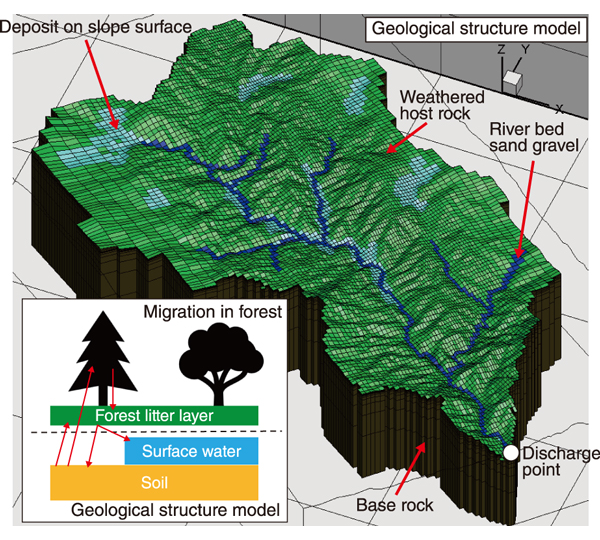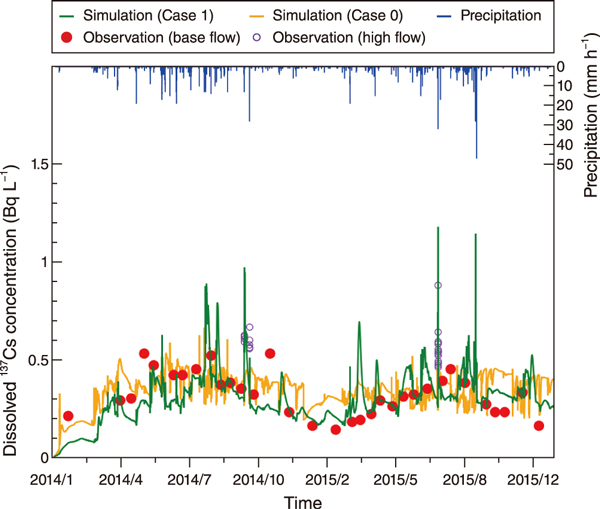Radioactivity Dynamics in River System
(2024)
QDoes defoliation of forests affect the concentration of cesium dissolved in river water?
AActual observations have shown that the concentration of cesium dissolved in river water fluctuates seasonally, with an increase at the time of water runoff, and a high concentration in summer and a low concentration in winter. In order to understand the mechanism of this phenomenon, we incorporated the phenomenon of dissolution from organic matter in forests into the model and conducted an analysis, and were able to reproduce two trends of change.
Since approximately 70% of the 137Cs from the accident at TEPCO’s Fukushima Daiichi Nuclear Power Station is present in forested areas that are not decontaminated, it is important to understand how 137Cs moves from forests to rivers to predict the 137Cs concentrations trends in agricultural crops and freshwater ecosystems. In particular, it is necessary to understand the behavior of not only particulate 137Cs but also dissolved 137Cs in river water, which is highly bioavailable. In a previous study, we simulated water, sediment, and 137Cs transport using a watershed model GETFLOWS(Learn more「Analytical study on environmental dynamics」(Japanese only)) for the upstream region of Ohta River (Fig.1); 99% of this region comprises forested area.
By comparing the measured and simulated results, we inferred that the dissolved 137Cs discharges in the forest are influenced by organic matter; in other words, the dissolved 137Cs is leached from the forest litter layer and discharged into the river. In this study, we incorporated the phenomena of 137Cs transfer in forests and dissolved 137Cs leaching from organic matter into the GETFLOWS model and compared the simulations with measurements to better understand the phenomena of discharge of dissolved 137Cs into rivers.

Fig. 1 Three-dimensional structural model of the area and 137Cs migration in a forest
GETFLOWS creates a three-dimensional model of the subsurface based on geological structures and a two-dimensional model of the surface based on elevation to simultaneously simulate surface water and groundwater. Based on the obtained hydrological cycle, GETFLOWS simulates the sediment and 137Cs transport in the surface layer, as well as 137Cs migration in the forest to predict 137Cs dynamics in the environment.
First, we confirmed the reproducibility of the model with respect to flow rate, sediment discharge, and dissolved 137Cs at the discharge point shown in Fig.1. We then modeled the transfer of 137Cs within the forest and among three-dimensional structural models shown by the red arrows in Fig.1 (inset). We simulated the concentration of dissolved 137Cs in river water at the runoff point shown in Fig.2 for the period January 2014-December 2015, depending on precipitation.

Fig.2 Simulation results of the dissolved and particulate 137Cs in river water
Case 0 was simulated assuming adsorption-distribution equilibrium for dissolved and particulate 137Cs, and Case 1 was modeled by considering trees and forest litter layers and linking the transfer within the forest to the watershed. Specifically, we modeled the availability of dissolved 137Cs, originating from organic matter decomposition and from the forest litter layer, to enter the river water due to an increase in the water level.
Case 0 represents the results of a previous study*, and Case 1 represents the results of this study. The results of simulation Case 0 (━), which assumes adsorption-distribution equilibrium (i.e., the dissolved and particulate 137Cs instantly adsorb and desorb in a certain ratio), are consistent with the measured dissolved 137Cs concentrations during base flow (0.14−0.53 Bq/L, mean: 0.32 Bq/L). However, the results did not fully reproduce the increase in dissolved 137Cs concentration during high flow (○) and the seasonal fluctuations (●), such as high levels in summer and low levels in winter. When the model was simulated by incorporating the transfer of 137Cs in forests and its dissolution from organic matter (━), these two trends of change was reproduced, albeit with some discrepancies between the measured and simulated values (correlation coefficients with measured values for cases 0 and 1 were −0.33 and 0.62). In other words, the dissolved 137Cs is considered to have leached from the forest litter layer and discharged into the river.
We will continue to clarify the mechanism of dissolved 137Cs leaching from the forest litter layer into rivers through river surveys and laboratory experiments to predict the decreasing trend of 137Cs concentration in the future and to evaluate countermeasures.
* Sakuma, K. et al., Applicability of Kd for Modelling Dissolved 137Cs Concentrations in Fukushima River Water: Case Study of the Upstream Ota River, Journal of Environmental Radioactivity, vols.184−185, 2018, p.53−62.
